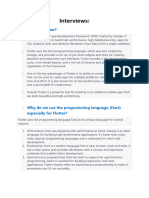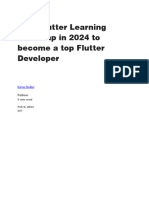Flutter_Fundamentals
Uploaded by
tictactoe005Flutter_Fundamentals
Uploaded by
tictactoe005Flutter Fundamentals
1. Introduction to Flutter
Flutter is an open-source UI software development toolkit created by Google. It is used to develop
cross-platform applications from a single codebase using the Dart language.
2. Flutter Architecture
Flutter apps are built using widgets. Everything in Flutter is a widget, including layout models and UI
elements.
3. Main Function and runApp()
The entry point of a Flutter app is the main() function, which calls runApp() to start the app.
Example:
void main() {
runApp(MyApp());
4. Widgets
Widgets are the building blocks of a Flutter app. There are two types:
- StatelessWidget: for static UI
- StatefulWidget: for dynamic UI
Example:
class MyApp extends StatelessWidget {
@override
Widget build(BuildContext context) {
return MaterialApp(
home: Scaffold(
appBar: AppBar(title: Text('Hello Flutter')),
body: Center(child: Text('Welcome to Flutter')),
),
);
5. Layouts
Flutter uses widgets for layout as well, such as Column, Row, Container, Padding, etc.
Example:
Column(
children: [
Text('Item 1'),
Text('Item 2'),
],
6. Navigation
Flutter provides a Navigator for navigating between screens.
Example:
Navigator.push(
context,
MaterialPageRoute(builder: (context) => SecondScreen()),
);
7. State Management
Managing state is crucial in Flutter. Common methods include:
- setState()
- Provider
- Riverpod
- Bloc
8. Hot Reload
Flutter supports hot reload, which allows developers to see changes instantly without restarting the
app.
9. Packages and Plugins
Flutter has a rich ecosystem of packages available through pub.dev to extend functionality (e.g.,
HTTP requests, local storage, Firebase).
10. Building and Running Apps
Use the Flutter CLI to build and run apps:
- flutter create my_app
- flutter run
- flutter build apk / ios
You might also like
- Pragmatic Flutter Building Cross Platform Mobile Apps For Android Ios Web Amp Desktop 9780367612092 9781032055657 9781003104636No ratings yetPragmatic Flutter Building Cross Platform Mobile Apps For Android Ios Web Amp Desktop 9780367612092 9781032055657 9781003104636457 pages
- Application Development Using Flutter and Dart_ACE-INTL-đã gộpNo ratings yetApplication Development Using Flutter and Dart_ACE-INTL-đã gộp232 pages
- FINALIZED FINISHED PROOF COPY of “Flutter in Full” - By Andrew Jeremiah Turner and Bard GeminiNo ratings yetFINALIZED FINISHED PROOF COPY of “Flutter in Full” - By Andrew Jeremiah Turner and Bard Gemini121 pages
- Application Development Using Flutter NotesNo ratings yetApplication Development Using Flutter Notes2 pages
- Flutter Essentials – Navigation, Routing, And State -- PARKER, JP -- 2024 -- Independently Published -- Ab0922453562aa65cf101616bead33f4 -- Anna’s ArchiveNo ratings yetFlutter Essentials – Navigation, Routing, And State -- PARKER, JP -- 2024 -- Independently Published -- Ab0922453562aa65cf101616bead33f4 -- Anna’s Archive124 pages
- EContent 11 2024 04 24 14 06 25 Unit1IntroductiontoFlutterpdf 2024 02 17 18 28 06No ratings yetEContent 11 2024 04 24 14 06 25 Unit1IntroductiontoFlutterpdf 2024 02 17 18 28 0644 pages
- Interview Questions For Flutter DevelopersNo ratings yetInterview Questions For Flutter Developers16 pages
- Introduction to Flutter and web DevelopmentNo ratings yetIntroduction to Flutter and web Development3 pages
- Building With Flutter: Google IO Extended - Minna JuneNo ratings yetBuilding With Flutter: Google IO Extended - Minna June39 pages
- Mobile App Development 2 2create Detai-WPS OfficeNo ratings yetMobile App Development 2 2create Detai-WPS Office6 pages
- Best Flutter Learning Roadmap in 2024 To Become A Top Flutter DeveloperNo ratings yetBest Flutter Learning Roadmap in 2024 To Become A Top Flutter Developer12 pages
- MAD Presentation Using Dart and FlutterNo ratings yetMAD Presentation Using Dart and Flutter20 pages
- Croma Campus - Flutter Training Curriculum AtulNo ratings yetCroma Campus - Flutter Training Curriculum Atul6 pages
- Www Edureka Co Blog Flutter Interview QuestionsNo ratings yetWww Edureka Co Blog Flutter Interview Questions25 pages



























































